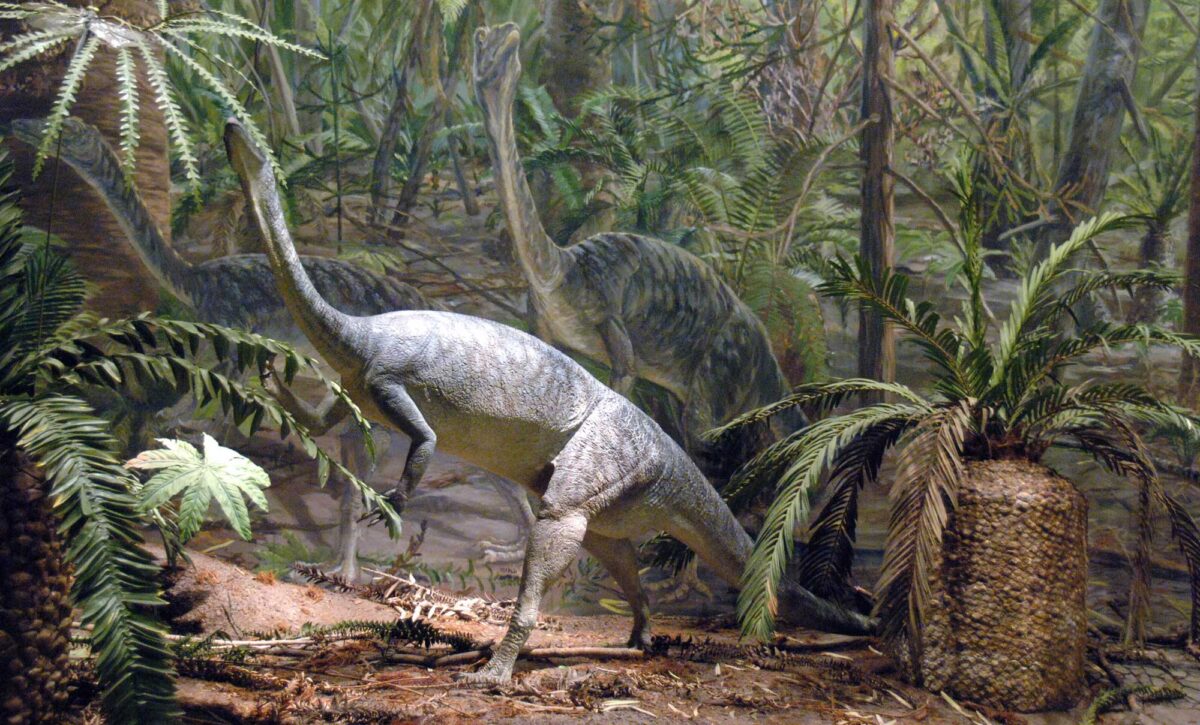Spotlight: Overview of the fossils of the Exotic Terrane region of the Northeastern United States.
Topics covered on this page: Overview; Paleozoic; Cambrian; Ordovician to Devonian; Carboniferous; Mesozoic; Cenozoic; Resources.
Credits: Most of the text of this page is derived from "Rocks of the Northeastern US" by Jane Elizabeth Ansley, from The Teacher-Friendly Guide to the Earth Science of the Northeastern US (published in 2000 by the Paleontological Research Institution, reprinted in 2016; currently out of print). The text was revised and expanded for Earth@Home web by Elizabeth J. Hermsen and Jonathan R. Hendricks in 2023, with contributions to this page also by Warren Allmon. Changes include formatting and revisions to the text and images. Credits for individual images are given in figure captions.
Updates: Page last updated October 23, 2023.
Image above: Mural depicting Anchisaurus from the Lower Jurassic of the Newark Supergroup, Dinosaur State Park, Connecticut. Anchisaurus bones have been found in both Connecticut and Massachusetts. Photo by JERRYE AND ROY KLOTZ MD (Wikimedia Commons, Creative Commons Attribution-ShareAlike 3.0 Unported license).
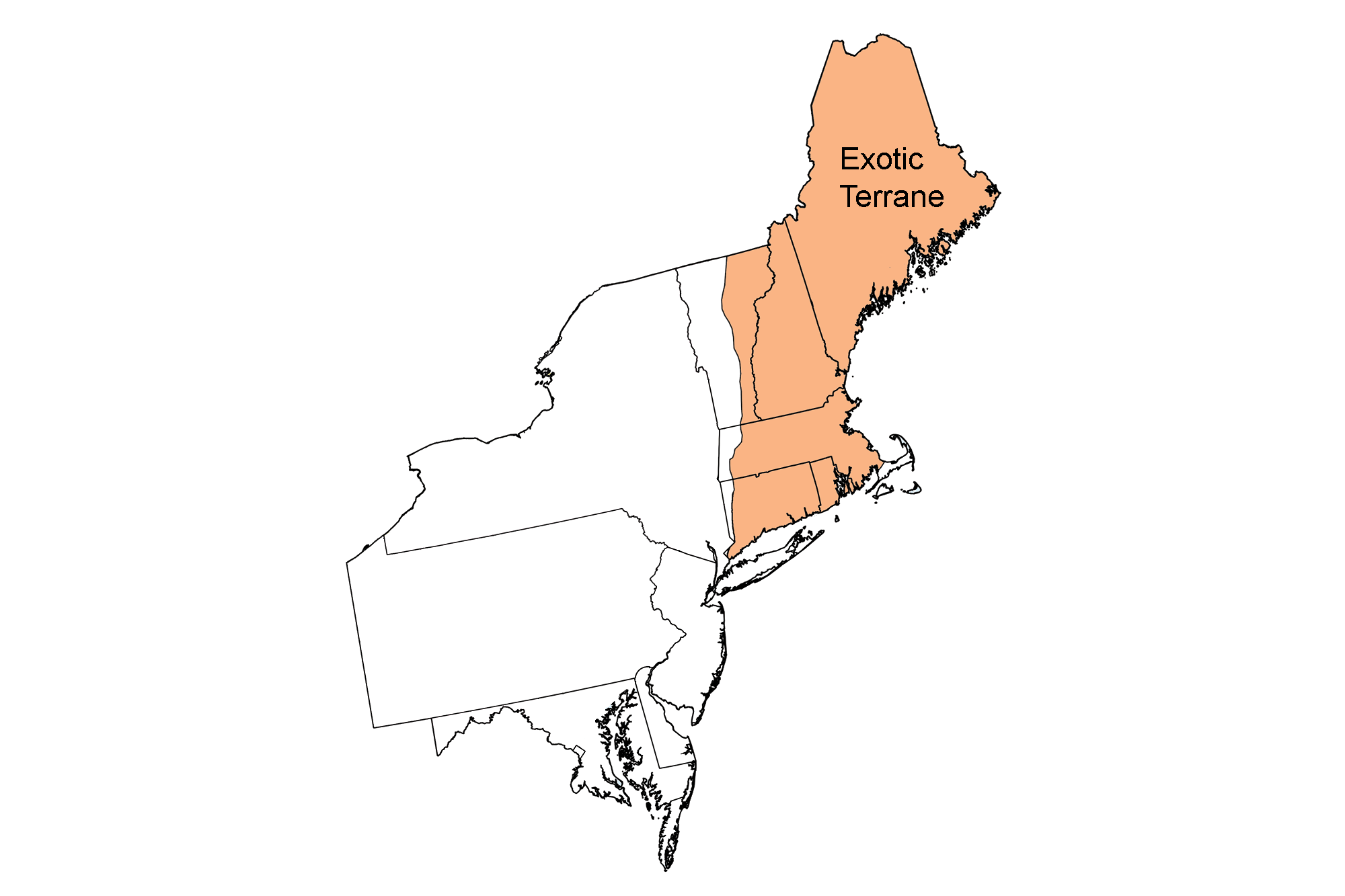
Overview
The Exotic Terrane region preserves some fossils from Paleozoic rocks from the Cambrian onward. The earliest fossils either come from accreted terranes or are fossils of organisms that lived in the Iapetus Ocean; thus, these fossils do not represent organisms that lived on the ancient North American landmass. Nevertheless, some younger Paleozoic (Carboniferous), Mesozoic, and Cenozoic fossils were deposited after accretion of the terranes to the Northeast and are remains of organisms that actually lived in the region and that were not transported from elsewhere.
Paleozoic fossils
Cambrian fossils
Boston and the surrounding area lies on a crustal fragment, which was probably at one time connected to what is now northwestern Africa. Fossils as old as the Cambrian are known from the eastern Massachusetts Boston Basin and are preserved in rocks of the exotic terrane called Avalonia. These rocks are believed to have originally been part of northern Africa; they were sutured to the side of North America during the Acadian mountain-building event. The Avalonia fragment was left attached to North America when the Atlantic Ocean began to form as Pangea began to come apart.
The fossil assemblages are like those in northern Africa but different from equivalent-aged fossils in North America. This “paradoxical” distribution gave the name to a group of Cambrian trilobites–Paradoxides–which today can be found in northern Africa and in the rocks around Boston, especially around the suburb of Braintree. The paradoxidid trilobites of the Braintree Slate are among the largest known trilobites. These fossil assemblages were among the earliest evidence for continental plate movement and exotic terranes.
Cambrian fossils from deepwater habitats are found in Maine. Like the fossils from the Boston Basin, these fossils did not originally form on the North American continent, but, rather, are from a fragment that was accreted later.

Paradoxites harlani, Middle Cambrian, Massachusetts, U.S.A. Museum of Comparative Zoology, Harvard University, specimen MCZ:IP-190330 (© President and Fellows of Harvard College, licensed under http://creativecommons.org/licenses/by-nc-sa/3.0/).
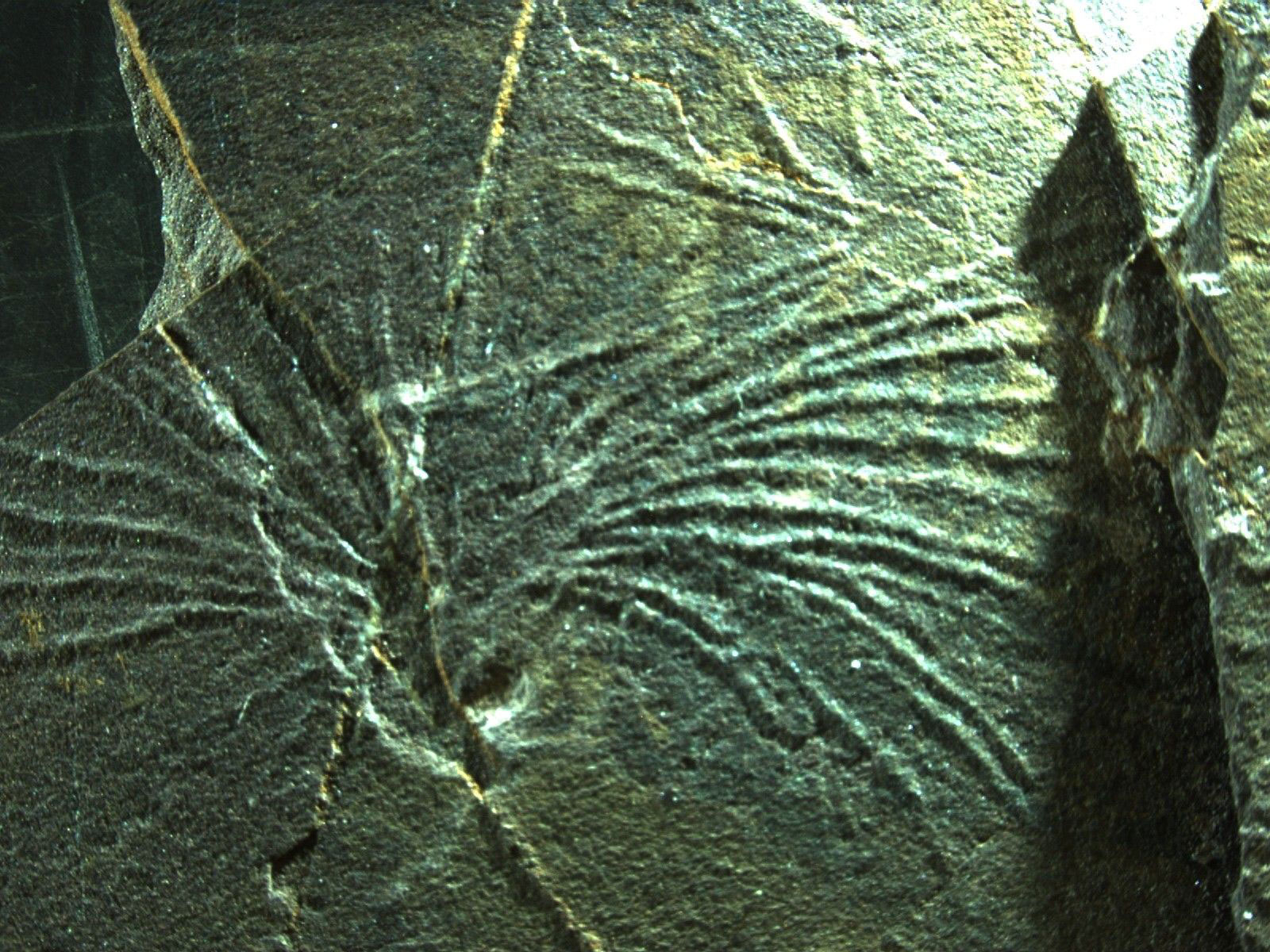
The trace fossil Oldhamia antiqua from the Lower Cambrian Grand Pitch Formation, Penobscot County, Maine. Photo of YPM IP 204557 by Maria G. Mangaon, Yale Peabody Museum, 2005 (CC0 1.0 Universal/public domain dedication).
Ordovician to Devonian fossils
Graptolites have been found in Ordovician rocks in Maine; these possibly existed within the Iapetus Ocean. Silurian and Devonian fossils (which also existed in the Paleozoic inland ocean) are found in limestones from Maine and New Hampshire, including corals, crinoids, brachiopods, trilobites, bryozoans, bivalves, and tentaculids. Devonian fossils in New Hampshire, though badly preserved in schist, include brachiopods. The Devonian trimerophyte (a type of early vascular plant) Pertica quadrifaria is preserved in parts of northern Maine, an area of the Exotic Terrane that experienced only weak metamorphism.
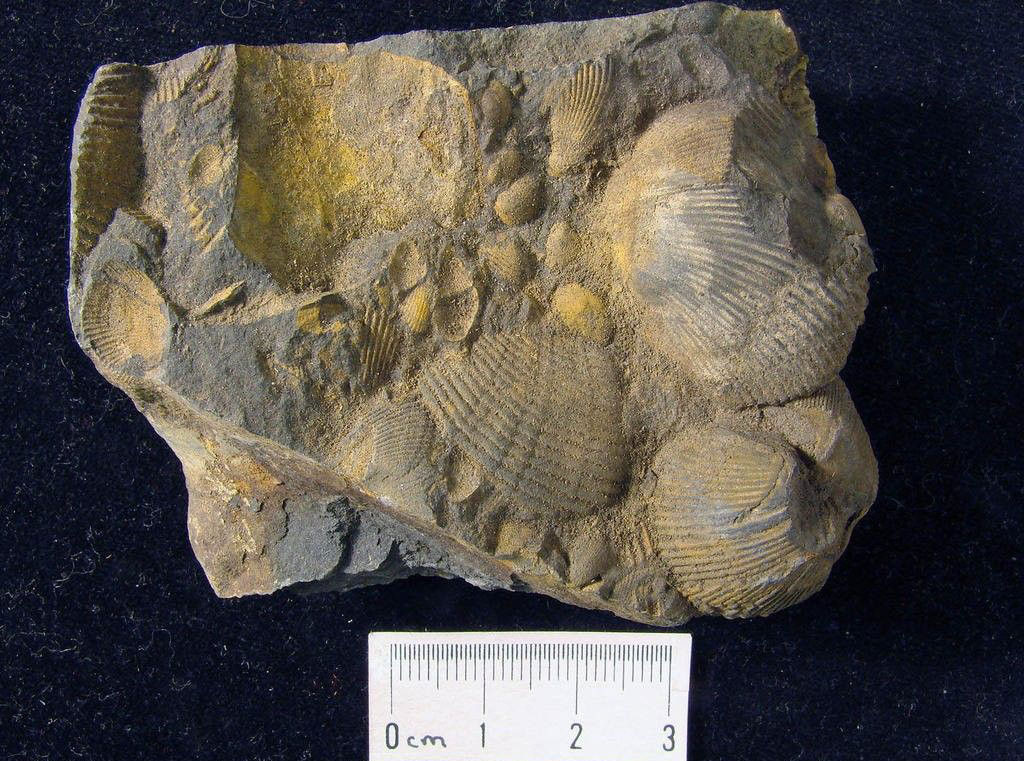
Brachiopods (Globithyris callida) from the Devonian of Somerset County, Maine. Photo of YPM IP 601904 by Jessica Utrup, Yale Peabody Museum, 2011 (CC0 1.0 Universal/public domain dedication).

The trimerophyte (a type of early vascular plant) Pertica quadrifaria from the Devonian of Piscataquis County, Maine. Photo of YPM PB 000468 by Robert Swerling, Yale Peabody Museum, 2020 (CC0 1.0 Universal/public domain dedication).
Carboniferous fossils
The Alleghanian Orogeny caused folding and uplift in the rocks of New England during the Carboniferous. In Rhode Island, the Narragansett Basin formed and eventually filled with sediments eroding off of surrounding highlands. Swamp forests grew in the basin, resulting in the formation of small coal deposits. These deposits include plant and animal fossils.
Pennsylvanian basins found in Rhode Island and Massachusetts contain a rich record of plant fossils and rarer amphibian tracks, insects, and arachnids. These fossils are similar to those preserved in Pennsylvanian-age rocks in the Inland Basin, although the deposits in the Exotic Terrane are less extensive. Pennsylvanian rocks of the Rhode Island Formation contain fossil insects, including some of the largest known cockroaches.
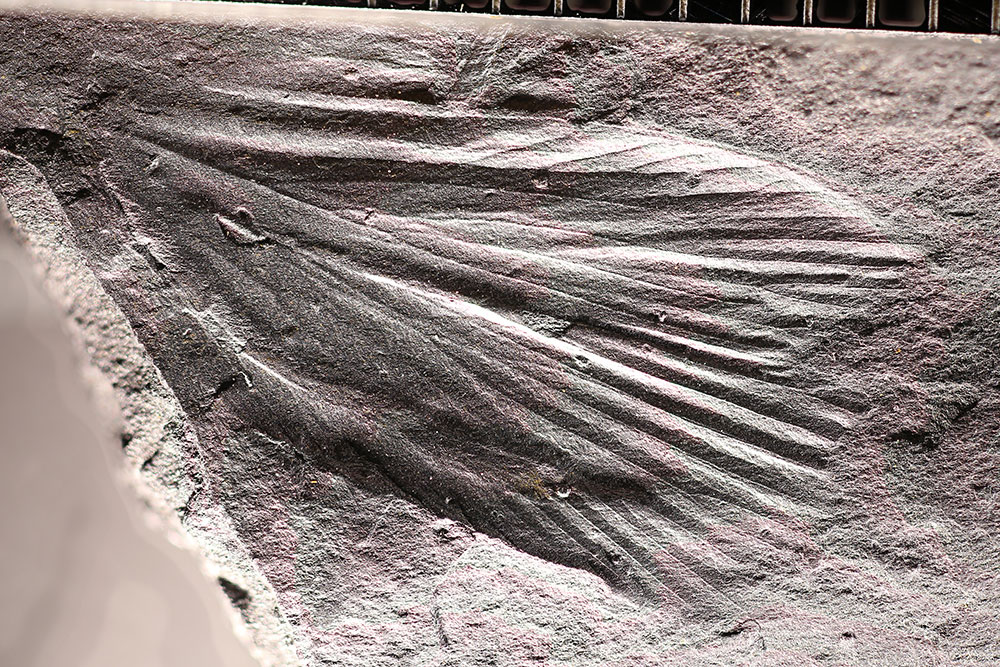
Wing of an ancient cockroach (Etoblattina), Carboniferous, Rhode Island, U.S.A. Museum of Comparative Zoology, Harvard University, specimen MCZ:Ent:PALE-13340 (© President and Fellows of Harvard College, licensed under http://creativecommons.org/licenses/by-nc-sa/3.0/).
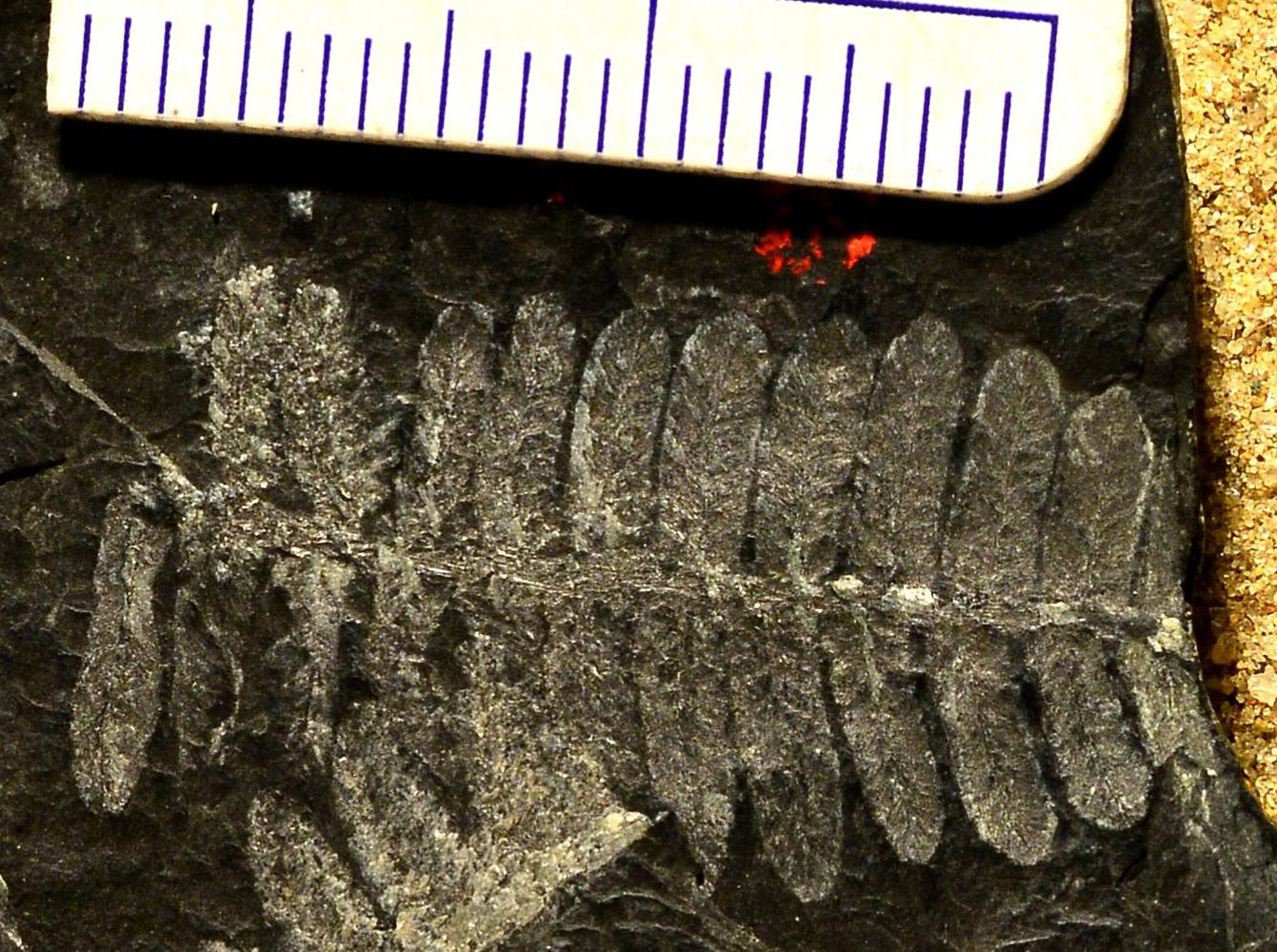
Foliage of a seed fern (Pecopteris sp.) from the Pennsylvanian of Rhode Island. Photo of YPM PB 172913 by Fiona O'Brien, Yale Peabody Museum, 2020 (CC0 1.0 Universal/public domain dedication).
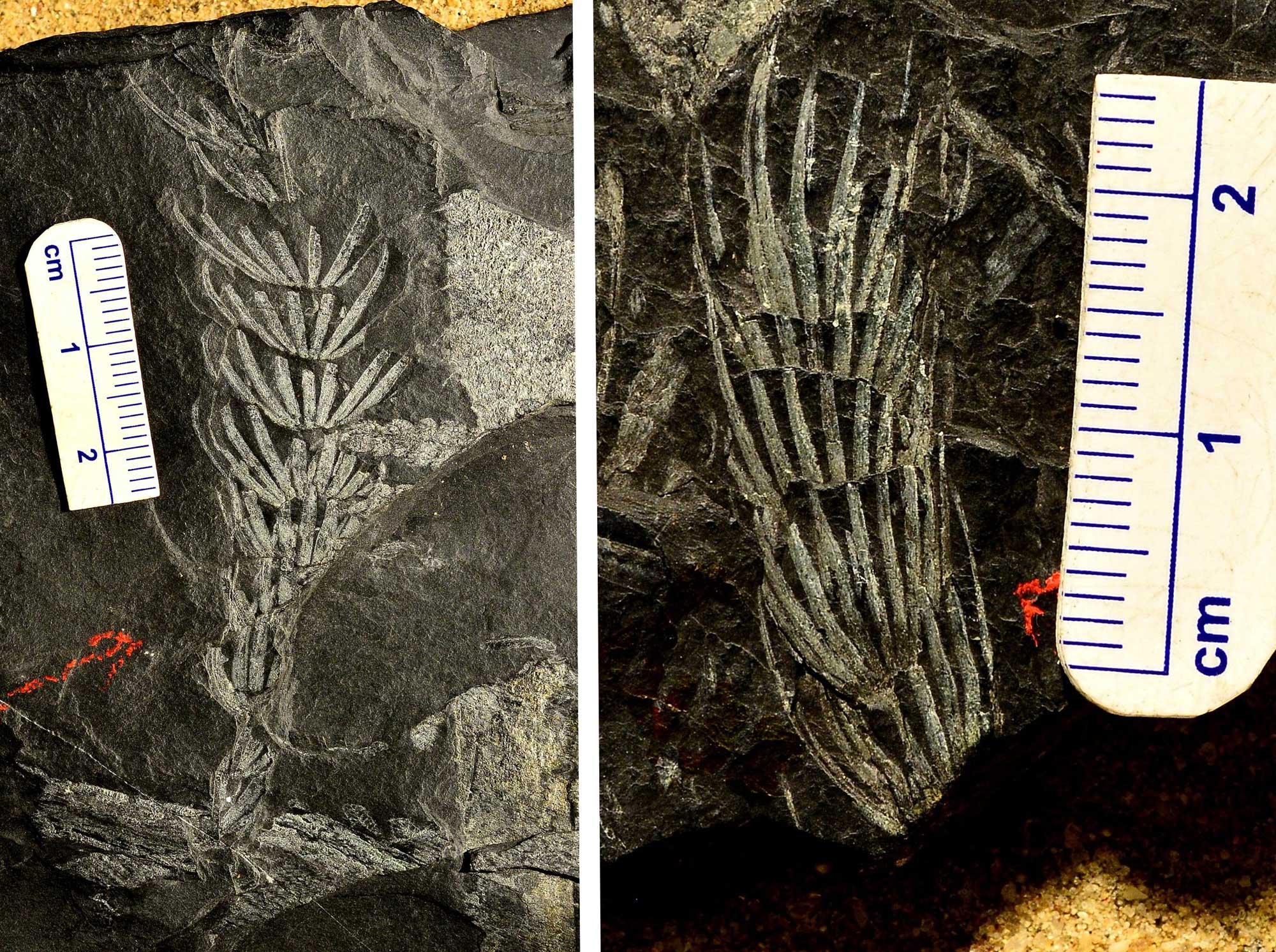
Two specimens of Asterophyllites from the Carboniferous of Rhode Island. Asterophyllites is a type of foliage produced by an ancient relative of modern horsetails. Photo of YPM PB 055476 and YPM PB 054438 by Fiona O'Brien, Yale Peabody Museum, 2020 (CC0 1.0 Universal/public domain dedication).
Mesozoic fossils
The Connecticut River Valley, which runs from Long Island Sound, through the middle of Connecticut and Massachusetts, and between Vermont and New Hampshire, is part of a failed rift basin, associated with the earliest phase of the breakup of Pangea in the Late Triassic and Early Jurassic. Between around 255 and 245 million years ago, this rift valley was filled with lakes similar to the Great Lakes of the East African rift valley today. In these lakes swam a great diversity of fishes, and along their shores walked a great diversity of terrestrial reptiles, including dinosaurs. These animals left abundant fossils in the shales and sandstones that accumulated in and around the lakes, which are called the Newark Series or Newark Supergroup. Fossils of the Newark Supergroup rift lakes are also found in Virginia and North Carolina in the southeastern U.S.
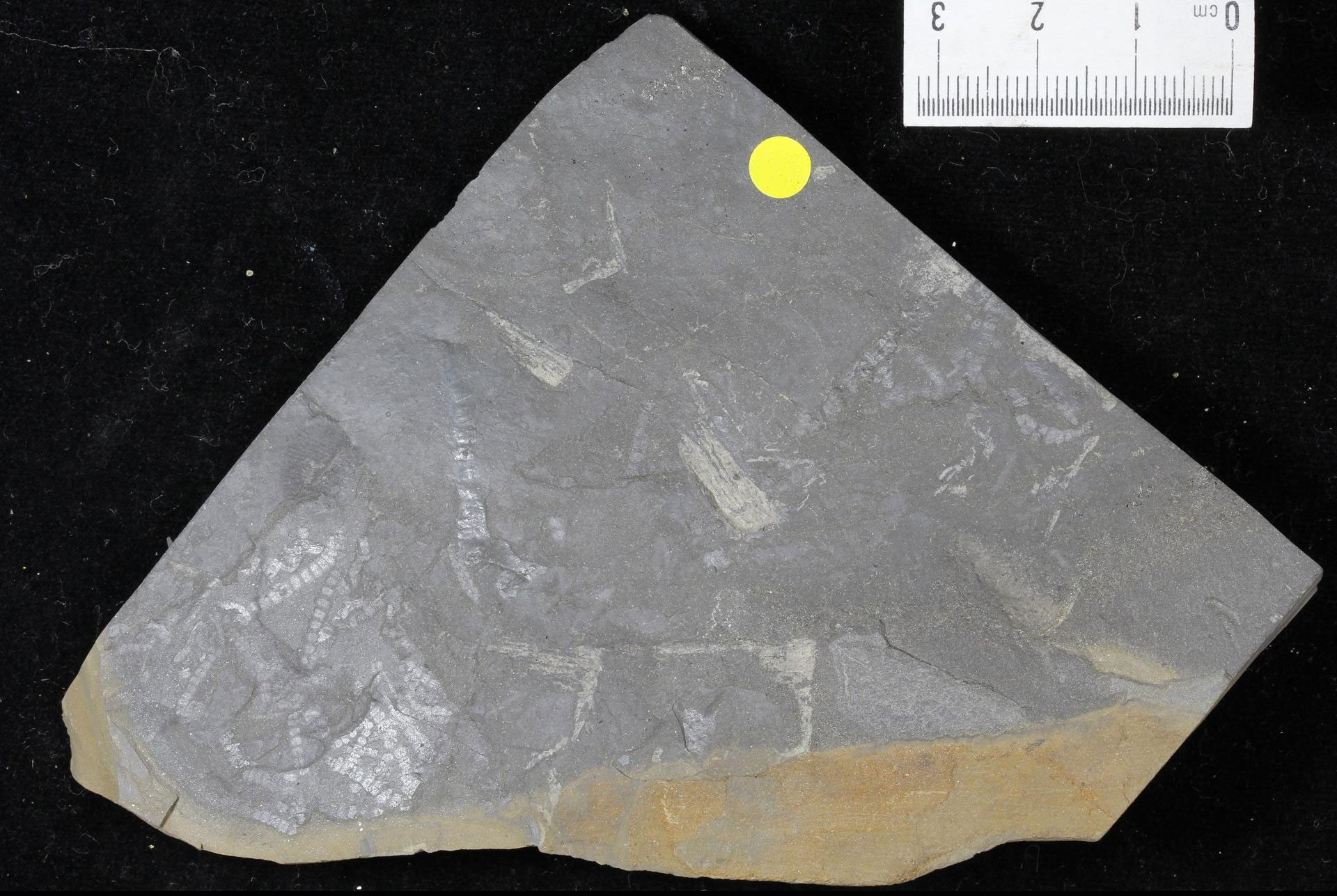
Mormolucoides, a type of beetle larva, from the Early Jurassic of Massachusetts. Photo of YPM IP 323638 by Jessica Utrup, Yale Peabody Museum, 2017 (CC0 1.0 Universal/public domain dedication).
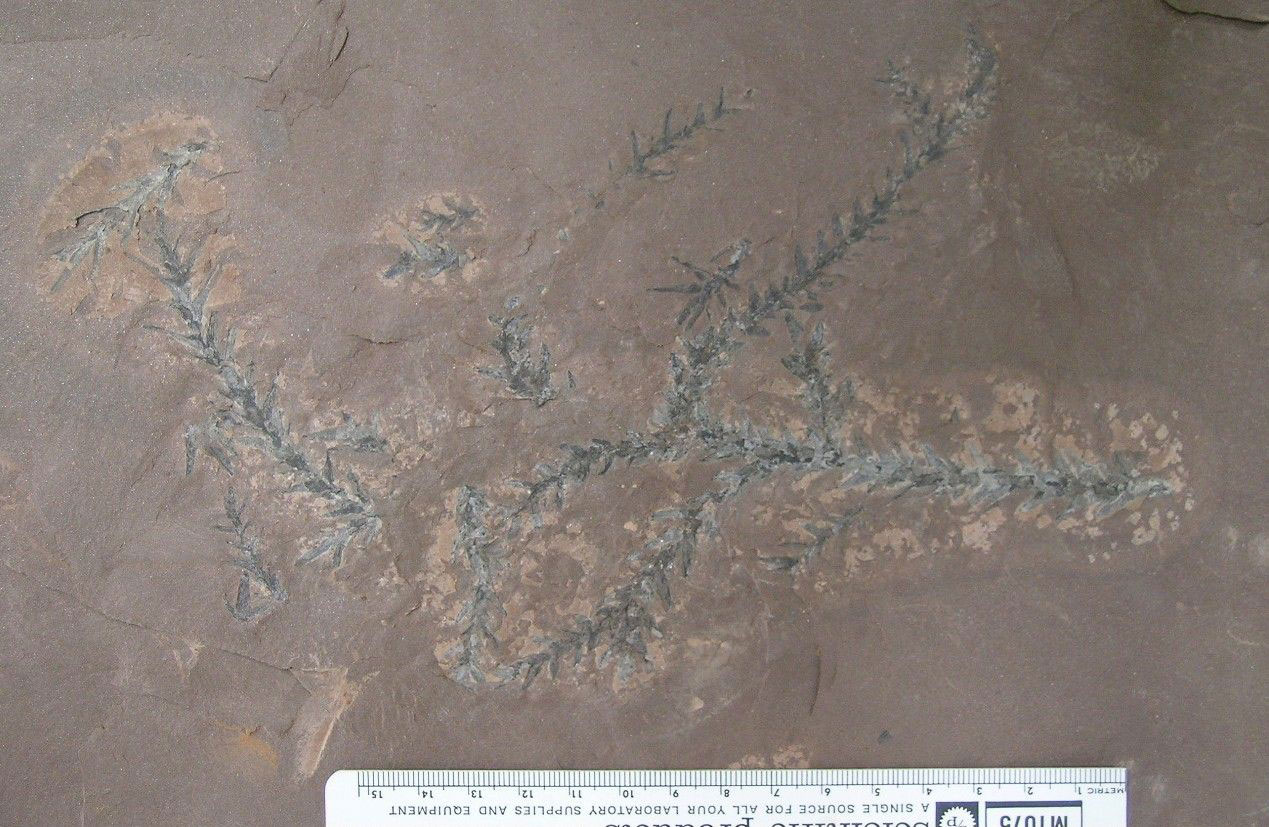
Branches and leaves of an extinct conifer (Geinitzia) from the Lower Jurassic Portland Formation, Hartford County, Connecticut. Photo of YPM PB 073285 by Division of Paleobotany, Yale Peabody Museum, 2005 (CC0 1.0 Universal/public domain dedication).
Fossil fish (semionotid) from the Triassic or Jurassic of Connecticut (PRI 53568). Specimen is from the research collections of the Paleontological Research Institution, Ithaca, New York. Fish is approximately 12.5 cm in length. Model by Emily Hauf.
Dinosaur trackways in this area are historically important. Pliny Moody (1790-1868) is the first person known to have found three-toed dinosaur footprints from the region around 1800. Edward Hitchcock (1793-1864), a geologist and professor at Amherst College in Massachusetts, later interpreted the abundant dinosaur tracks in the region as bird footprints.
In the New England area, several areas with trackways have been preserved for the public. Dinosaur Footprints in Holyoke, Massachusetts, is a park that conserves footprints discovered in the 1920s during highway construction. Hundreds of footprints discovered in the 1960s during another construction project are preserved under a dome at Dinosaur State Park in Connecticut. Eubrontes, one of the types of tracks found in the Connecticut Valley, is the state fossil of Connecticut.
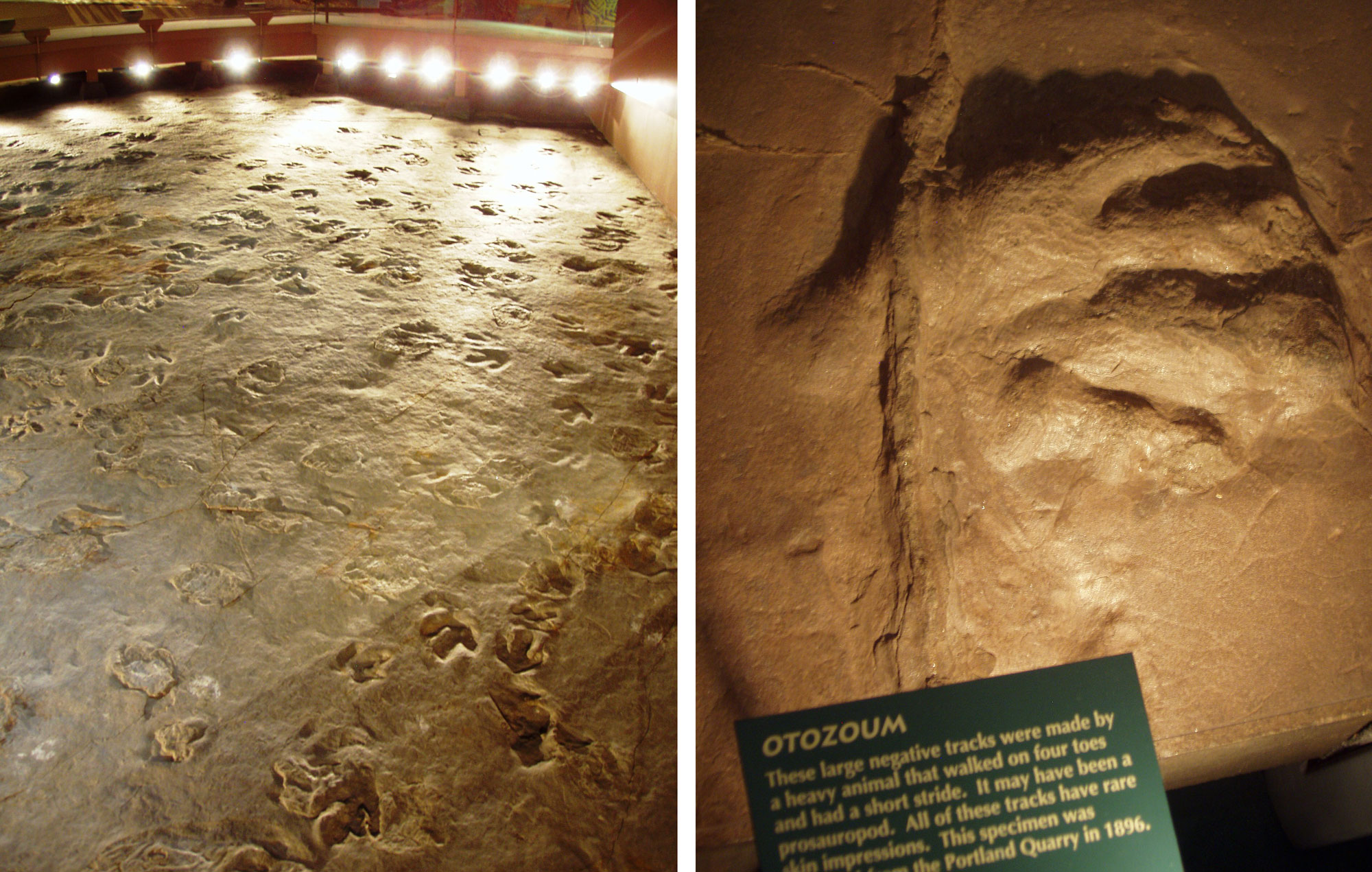
Dinosaur tracks from the Connecticut River Vally. Left: Dinosaur tracks at Dinosaur State Park in Connecticut. Right: Four-toed track called Otozoum (a possible prosauropod track) from Portland Quarry, Connecticut, collected in 1896. Specimen on display at Dinosaur State Park. Left photo and right photo by Daderot (Wikimedia Commons, Creative Commons Attribution-ShareAlike 3.0 Unported license).
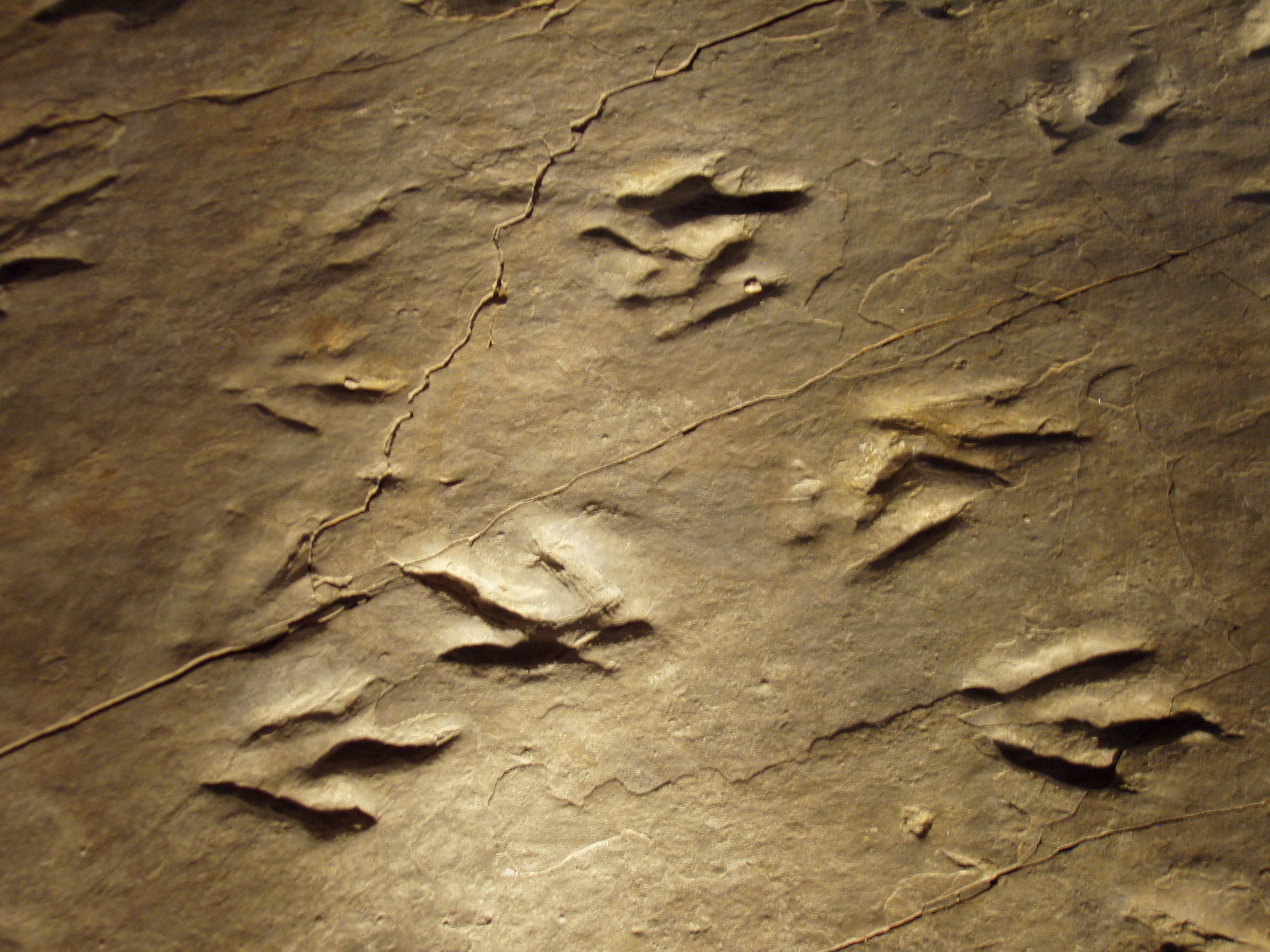
Dinosaur tracks at Dinosaur State Park in Connecticut. Photo by Daderot (Wikimedia Commons, Creative Commons Attribution-ShareAlike 3.0 Unported license).
Fossil specimen of the dinosaur footprint Grallator sp. from the Jurassic of Connecticut (PRI 40798); footprint likely made by the dinosaur Coelophysis. Specimen is from the collections of the Paleontological Research Institution, Ithaca, New York. Length of footprint (not including surrounding rock) is approximately 13 cm. Model by Emily Hauf.
While dinosaur footprints are common in the Connecticut River Valley, bones are rare. One of the few fossil dinosaur skeletons that has been found is that of Podokesaurus holyokensis, a housecat-sized Triassic dinosaur that walked on two legs. The skeleton of Podokesaurus was discovered by Mignon Talbot (1869-1950), a professor at Mount Holyoke College in Massachusetts, in 1910 while she was out walking with her sister. Talbot described Podokesaurus in 1911. Unfortunately, the fossil was destroyed in a fire in 1916, and no other fossils of Podokesaurus have been discovered. Podokesaurus was designated the state dinosaur of Massachusetts in 2021.
The Early Jurassic prosauropod dinosaur Anchisaurus polyzelus has also been found in the Newark Supergroup of Massachusetts and Connecticut. Anchisaurus may be the dinosaur that made Eubrontes tracks.
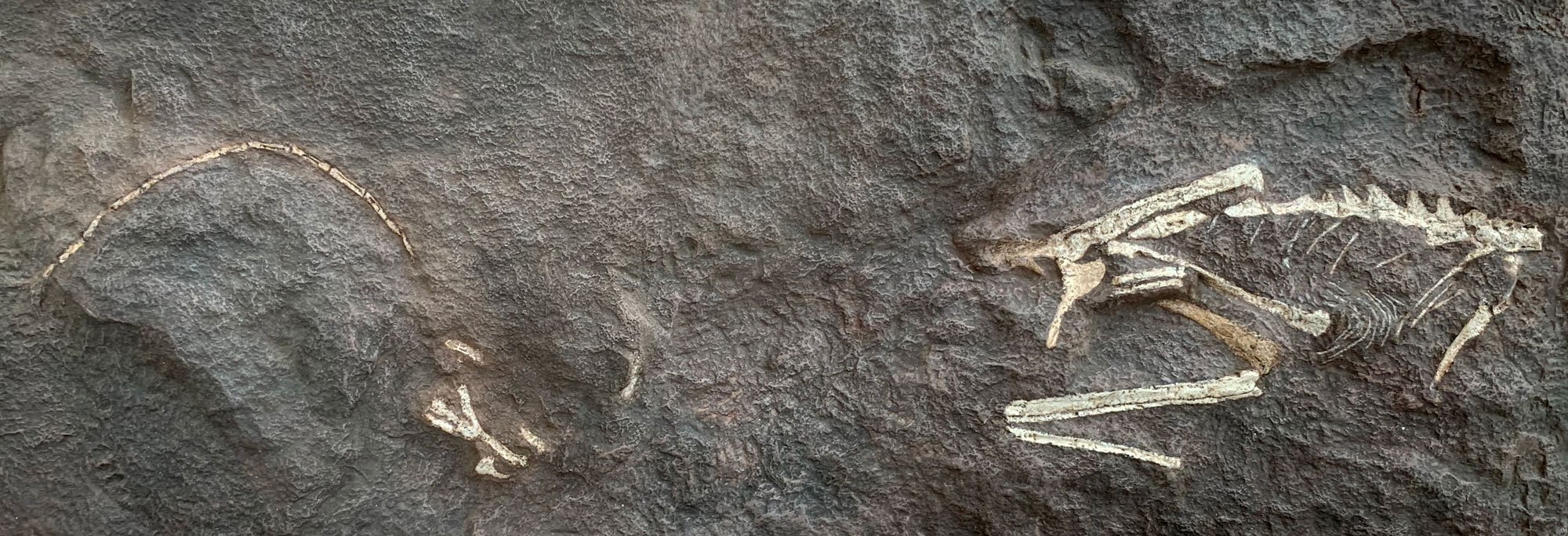
Cast (reproduction) of the specimen of Podokesaurus holyokensis. Fortunately, prior to the fire that destroyed the only original specimen, casts of it were made. This cast is held by the Yale Peabody Museum in Connecticut. Photo by Jonathan R. Hendricks.
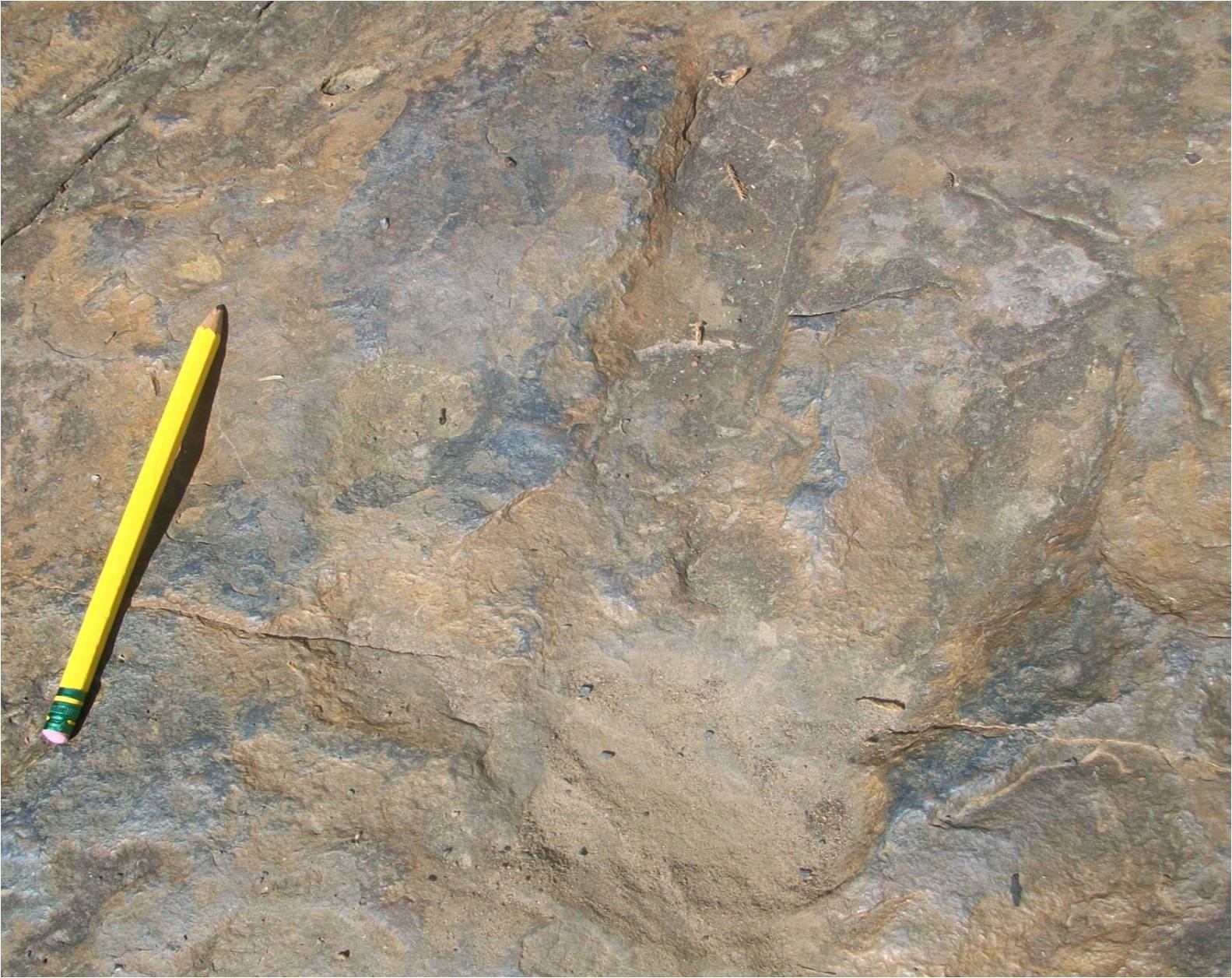
A Eubrontes track at Dinosaur Footprints in Massachusetts. Photo by Smokeybjb (Wikimedia Commons, Creative Commons Attribution-ShareAlike 3.0 Unported license).
Cenozoic fossils
While woolly mammoths (Mammuthus primigenius) and other Pleistocene mammals roamed New England during interglacial intervals when the region was not covered by large sheets of ice, relatively few Pleistocene fossils are preserved. The scarcity of Pleistocene fossils in the region is probably a result of the destruction of fossils during periods of glaciation and the acidity of the soil, which dissolves bone over time.
Plant fossils have been recorded from lake sediments of Glacial Lake Hitchcock in eastern Vermont, as well as other places in the region.
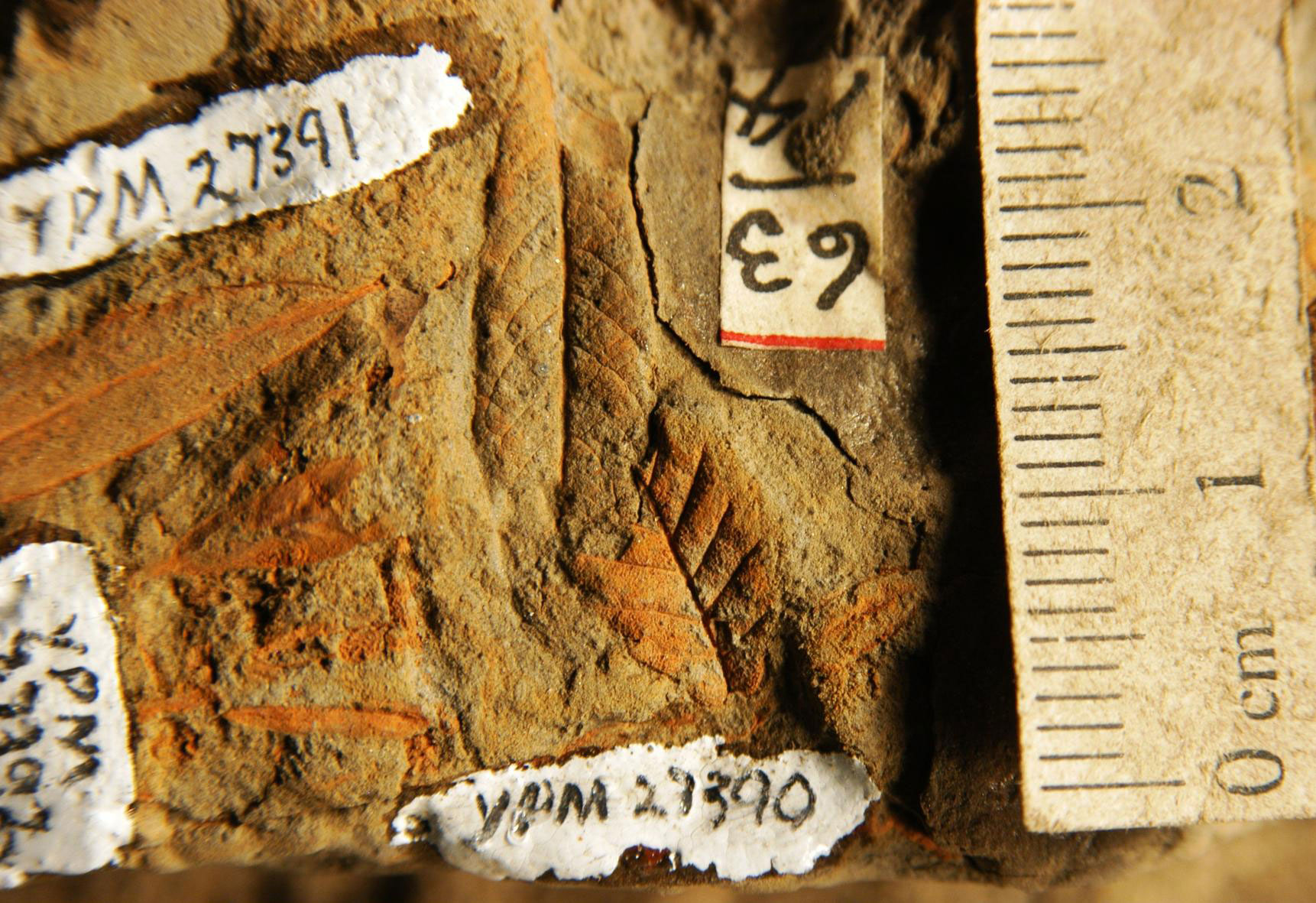
Leaves of Dryas drummondii (a species in the Rose Family, Rosaceae) from sediments of Glacial Lake Hitchcock, Pleistocene, Coos County, Vermont. Photo of YPM PB 027390 by Division of Paleobotany, Yale Peabody Museum, 2015 (CC0 1.0 Universal/public domain dedication).
Resources
Resources from the Paleontological Research Institution
Daring to Dig: Orra Hitchcock [wife of Edward Hitchcock, illustrator for some of his works and classroom materials]: https://www.museumoftheearth.org/daring-to-dig/bio/hitchcock
Daring to Dig: Mignon Talbot: https://www.museumoftheearth.org/daring-to-dig/bio/talbot
Digital Atlas of Ancient Life Virtual Collection: https://www.digitalatlasofancientlife.org/vc/ (Virtual fossil collection featuring 3D models of fossil specimens sorted by group)
Digital Encyclopedia of Ancient Life: https://www.digitalatlasofancientlife.org/learn/
Earth@Home: Quick guide to common fossils: https://earthathome.org/quick-faqs/quick-guide-common-fossils/



